

Toughened safety glass (TSG)
Toughened safety glass is a tempered glass in accordance with EN 12150-1 which is subjected to a heat treatment process in order to give it a high degree of internal tension. This makes it significantly more resistant to impact than normal flat glass.
TSG-H
TSG-H is the abbreviation used for toughened safety glass (TSG) that has been subjected to a heat-soak test. During this process, the pre-tensioned glass is placed in a special heat-soak furnace for several hours, where it is subjected to a temperature of 290°C. The heat-soak test prevents spontaneous glass breakage, and is recommended for glass that will be required to fulfil demanding structural requirements.
Laminated safety glass (LSG)
While TSG comprises just one impact-resistant pane of glass, laminated safety glass (LSG) is a composite of two panes of glass bonded together using a viscoplastic, tear-proof film. Unlike TSG, VSG does not shatter into small crumbs if it breaks; instead, the broken glass sticks to the PVB film, which holds it together so that it can continue to provide protection.